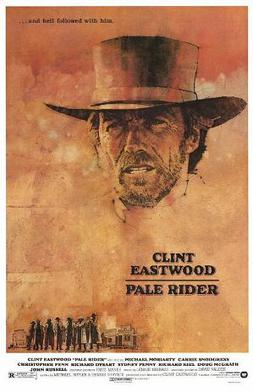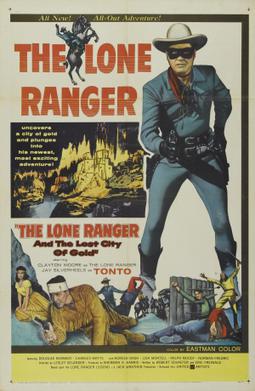
The Four Horsemen of the Apocalypse are figures in the Book of Revelation in the New Testament of the Bible, a piece of apocalypse literature attributed to John of Patmos. Similar allusions are contained in the Old Testament books of Ezekiel and Zechariah, written about six centuries prior. Though the text only provides a name for the fourth horseman, subsequent commentary often identifies them as personifications of Conquest (Zelos), War (Ares), Famine (Limos), and Death.

Pale Rider is a 1985 American Western film produced and directed by Clint Eastwood, who also stars in the lead role. The title is a reference to the Four Horsemen of the Apocalypse, as the pale horse's ghost rider (Eastwood) represents Death. The film, which took in over $41 million at the box office, became the highest-grossing Western of the 1980s.

The Spanish Riding School is an Austrian institution dedicated to the preservation of classical dressage and the training of Lipizzaner horses, based in Vienna, Austria, whose performances in the Hofburg are also a tourist attraction. The leading horses and riders of the school also periodically tour and perform worldwide. It is one of the "Big Four", the most prestigious classical riding academies in the world, alongside the Cadre Noir, the Portuguese School of Equestrian Art, and the Royal Andalusian School.
A hunter pace is a form of competition involving horses and riders. In a hunter pace a trail is marked for horse and rider to follow. On the day of the competition, early in the morning, the hosts of the event send an experienced horse and rider to ride the trail as fast as it is safely possible to do so. This morning ride is called "the dead body run", and it establishes two things:
Equestrian competitions at the 1968 Summer Olympics in Mexico City, Mexico featured team and individual competitions in show jumping, eventing, and dressage. Mexico City proved a challenging site since it was 2,300 meters above sea level, resulting in 30% less oxygen in the air. The horses at the 1955 Pan American Games, which was also held in Mexico City, arrived a few weeks before the Games to adjust, but had difficulty in the competition. However, racehorses that competed at the same location and who were shipped in the day before, and left the day after the race, performed fine. It was discovered that although horses would adjust immediately to the high altitude during the first few days after arrival, they showed weakness and decreased performance around Day 10, which continued to Day 20. Therefore, nations were advised to ship in horses 3–4 weeks before the competition, which would allow them time to recover from the long travel, as well as adjust to the difference in altitude. Argentina, Ireland, and the USSR were the first to ship horses over, who arrived mid-September. France and Germany were the last countries to send their horses, who arrived 28 September 20 days before the competition was to start.

Earl Harold Sande was an American Hall of Fame jockey and thoroughbred horse trainer.

Malin Birgitta Barijard Johnsson, born 10 April 1975 in Söderköping, Östergötland, Sweden) is a Swedish equestrian, competing in show jumping. Baryard started to ride at the age of six and went on to be a very accomplished show jumper. She won a gold medal in the Swedish Championships at the age of just 14. She married Swedish TV presenter Henrik Johnsson in the summer of 2004, and made her TV-presenting debut in the autumn of 2004 on the SVT show Barbacka.

The Dawn Rider is a 1935 American Western film starring John Wayne and directed by Robert N. Bradbury.

Equestrian sports were first included in the Olympic Games in the Summer Olympics of 1900 in Paris. They were again included in 1912, and have been included in every subsequent edition of the Games. Currently, the Olympic equestrian disciplines are dressage, eventing, and show jumping. In each discipline, both individual and team medals are awarded. Since the XV Olympiad in Helsinki in 1952, women and men compete on equal terms.

Matthew Morgan "Matt" Ryan, OAM is an Olympic-level equestrian rider. He is a triple Olympic gold medalist who competed for Australia. Matt has three older brothers, including the internationally successful eventer and dressage rider, Heath Ryan. In 1984. he travelled to Britain to train with the great Richard Meade, before returning home the following year, and then went back to the UK in 1989 to set up a stable.

Miracle of the White Stallions is a 1963 American adventure war film released by Walt Disney starring Robert Taylor, Lilli Palmer, and Eddie Albert. It is based on the story of Operation Cowboy which was the evacuation of the Lipizzaner horses from the Spanish Riding School in Vienna during World War II. Major parts of the movie were shot at the Hermesvilla palace in the Lainzer Tiergarten of Vienna, a former hunting area for the Habsburg nobility. The music for the soundtrack was based on the first movement of Franz Schubert's Marche Militaire no 1, D733.

Count Hans Robert von Rosen was a Swedish Army captain and horse rider who competed in the 1912 Summer Olympics and in the 1920 Summer Olympics.

Georg Gustaf Wilhelm von Braun was a Swedish horse rider who competed in the 1920 and 1924 Summer Olympics. In 1920 he and his horse Diana finished eighth in the individual eventing competition and won a gold medal with the Swedish eventing team. Four years later he finished 19th in the individual jumping and was a member of the gold medal-winning Swedish team. He did not receive any medal for that at the time, but is listed as a gold medalist for that too on IOC's site.

Elizabeth Madden is an American Olympic champion equestrian competing in show jumping. She has two Olympic golds and one silver in team jumping, and an individual bronze. She won the FEI Show Jumping World Cup twice; won two silvers and two bronzes at World Championships; and won two golds, one silver and two bronzes at the Pan American Games. She was the first American to break into the international top three show jumping ranking, and the first woman to win over one million dollars in show jumping prize money.

Andreas Dibowski is a German eventing rider. With his horse Butts Leon he won a gold medal in team eventing at the 2008 Summer Olympics.

Sergei Ivanovich Filatov was a Soviet equestrian who competed in the mixed dressage at the 1956, 1960 and 1964 Olympics. He won individual gold in 1960 and two bronze medals in 1964, individual and with the Soviet team. His 1960 gold was the first achievement of this rank for a Soviet rider.
Peter Charles, is a British equestrian who competes in the sport of show jumping.

The Lone Ranger and the Lost City of Gold is a 1958 American Western film in Eastmancolor released by United Artists. The second of two theatrical features specifically based on and continuing the TV show The Lone Ranger it stars Clayton Moore and Jay Silverheels, reprising their roles from the TV series. The first feature film was 1956's The Lone Ranger. No further films based on this specific version of the characters were made after this one.

The 1995 Grand National was the 148th official renewal of the famous Grand National steeplechase that took place at Aintree near Liverpool, England, on 8 April 1995.

Charlotte Susan Jane Dujardin is a British dressage rider, equestrian and writer. A multiple World and Olympic champion, Dujardin has been described as the dominant dressage rider of her era. She held the complete set of available individual elite dressage titles at one point: the individual Olympic freestyle, World freestyle and Grand Prix Special, World Cup individual dressage and European freestyle, and Grand Prix Special titles. Dujardin was the first rider to hold this complete set of titles at the same time.

















